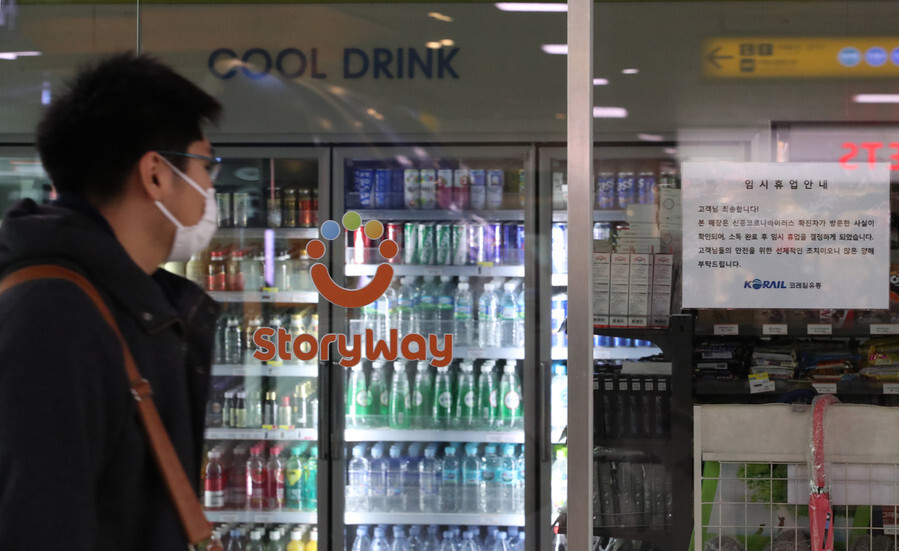hankyoreh
Links to other country sites 다른 나라 사이트 링크
Coronavirus spurs negative forecasts for S. Korean economy

The mounting number of novel coronavirus infections is fanning fears of potential blows to both exports and domestic demand for the South Korean economy.
In reports published on Feb. 2, financial and research institutions predicted the novel coronavirus outbreak would have a greater ripple effect on the South Korean economy than SARS in 2003. In a report that day on “The Effects of the Virus on the Domestic Economy and Exchange Rate,” Korea Investment and Securities (KIS) noted, “During the SARS [outbreak] in 2003, the travel deficit was reduced because the decline in the amount spent by South Koreans traveling overseas [travel expenditures] was larger than the amount spent by international visitors in South Korea [travel revenues].”
“But with the percentage of Chinese tourists now more than triple the number was at the time of SARS, the decline in travel revenues could be greater,” it warned.
KIS went on to say the novel coronavirus was “predicted to have a highly negative impact on the domestic economy in the short term.”
“Expectations that the economy has passed through its trough will seemingly have to be deferred, and a decline in the growth rate appears inevitable through at least the first or second quarter,” it added.
During the SARS outbreak, South Korean exports to China also took a hit amid stagnation in Chinese domestic demand. Some are predicting China’s growth rate could slip from 6.1% last year to below 5% in 2020 due to the novel coronavirus infections. With China accounting for 25% of all South Korean exports, this means a growing likelihood that they will suffer a direct hit.
The SARS outbreak in 2003 saw only three infections in South Korea, which meant that declining exports to China were a larger factor than shrinking domestic demand. But with the novel coronavirus infections, domestic demand is already suffering, with the number of confirmed cases in South Korea reaching 15 as of Feb. 2. The decline in consumption could end up unfolding along similar lines to the MERS outbreak in 2015, in which 186 infections occurred in South Korea. In a report on “Ripple Effects of Novel Coronavirus Infections on the South Korean Economy” published on Jan. 31, Hyundai Research Institute projected a decrease of up to 0.4 percentage points in domestic consumption during the first quarter. It also predicted the annual economic growth rate could fall by up to 0.2 percentage points.
“Avoiding a ‘double dip’ situation [in which the economy seems to be recovering only to stagnate once again] will require the development of a step-by-step policy response along the same lines as the ‘super supplementary budget’ [11.5 trillion won, or US$9.6 billion] at the time of the MERS situation,” the institute said.
While it is not yet considering a supplementary budget, the South Korean government did announce that its response measures would change depending on how the virus outbreak situation progresses.
“We’ve been examining past responses and developing countermeasures for different scenarios,” said a senior official with the Ministry of Economy and Finance. In particular, the government is paying close attention to the Chinese economy, which it views as the largest variable.
By Lee Kyung-mi, staff reporter
Please direct comments or questions to [english@hani.co.kr]

Editorial・opinion
![[Editorial] Penalties for airing allegations against Korea’s first lady endanger free press [Editorial] Penalties for airing allegations against Korea’s first lady endanger free press](https://flexible.img.hani.co.kr/flexible/normal/500/300/imgdb/original/2024/0502/1817146398095106.jpg) [Editorial] Penalties for airing allegations against Korea’s first lady endanger free press
[Editorial] Penalties for airing allegations against Korea’s first lady endanger free press![[Editorial] Yoon must halt procurement of SM-3 interceptor missiles [Editorial] Yoon must halt procurement of SM-3 interceptor missiles](https://flexible.img.hani.co.kr/flexible/normal/500/300/imgdb/child/2024/0501/17145495551605_1717145495195344.jpg) [Editorial] Yoon must halt procurement of SM-3 interceptor missiles
[Editorial] Yoon must halt procurement of SM-3 interceptor missiles- [Guest essay] Maybe Korea’s rapid population decline is an opportunity, not a crisis
- [Column] Can Yoon steer diplomacy with Russia, China back on track?
- [Column] Season 2 of special prosecutor probe may be coming to Korea soon
- [Column] Park Geun-hye déjà vu in Yoon Suk-yeol
- [Editorial] New weight of N. Korea’s nuclear threats makes dialogue all the more urgent
- [Guest essay] The real reason Korea’s new right wants to dub Rhee a founding father
- [Column] ‘Choson’: Is it time we start referring to N. Korea in its own terms?
- [Editorial] Japan’s rewriting of history with Korea has gone too far
Most viewed articles
- 160% of young Koreans see no need to have kids after marriage
- 2Presidential office warns of veto in response to opposition passing special counsel probe act
- 3[Editorial] Penalties for airing allegations against Korea’s first lady endanger free press
- 4Months and months of overdue wages are pushing migrant workers in Korea into debt
- 5Anti-immigration candidate marauds across Korea with squad detaining foreigners
- 6Hybe-Ador dispute shines light on pervasive issues behind K-pop’s tidy facade
- 7[Reporter’s notebook] In Min’s world, she’s the artist — and NewJeans is her art
- 8Inside the law for a special counsel probe over a Korean Marine’s death
- 9Japan says it’s not pressuring Naver to sell Line, but Korean insiders say otherwise
- 10Alleged drug use by Korean A-listers rocks nation – but not for the first time